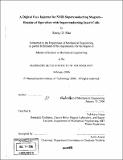| dc.contributor.advisor | Yukikazu Iwasa. | en_US |
| dc.contributor.author | Mai, Rocky D. (Rocky Dikang) | en_US |
| dc.contributor.other | Massachusetts Institute of Technology. Dept. of Mechanical Engineering. | en_US |
| dc.date.accessioned | 2007-01-10T16:59:30Z | |
| dc.date.available | 2007-01-10T16:59:30Z | |
| dc.date.copyright | 2006 | en_US |
| dc.date.issued | 2006 | en_US |
| dc.identifier.uri | http://hdl.handle.net/1721.1/35668 | |
| dc.description | Thesis (S.M.)--Massachusetts Institute of Technology, Dept. of Mechanical Engineering, 2006. | en_US |
| dc.description | Includes bibliographical references (leaf 71). | en_US |
| dc.description.abstract | It has been known for some time that high-temperature superconductors (HTS) are critical for the construction of NMR magnets generating 1 GHz and above. Such systems generally require an HTS insert to be placed in the inner high-field region of a low temperature superconducting (LTS) magnet. Among the problems in the presently available HTS technology are splice resistance and index dissipation, which make it essentially impossible for HTS to operate in persistent mode. Unless operated in driven mode with a very stable power supply, the HTS insert generally cannot achieve NMR-quality temporal stability. Another option, proposed by Iwasa, is by the use of a digital flux injector (DFI), which is a transformer type of device that can inject a quantified amount of magnetic flux into a "slightly" resistive magnet to compensate the energy dissipation over time. Previous work at the Francis Bitter Magnet Laboratory (FBML) showed a prototype DFI operate successfully with an LTS insert magnet and demonstrated the basic concepts of this alternative approach. Based on the prototype, the first full-scale DFI has been designed, built and operated with an LTS insert magnet and an HTS insert magnet separately. The design process, operation procedure and experimental results are the main topics of discussion in this thesis. | en_US |
| dc.description.statementofresponsibility | by Rocky D. Mai. | en_US |
| dc.format.extent | 101 leaves | en_US |
| dc.format.extent | 4933855 bytes | |
| dc.format.extent | 4938028 bytes | |
| dc.format.mimetype | application/pdf | |
| dc.format.mimetype | application/pdf | |
| dc.language.iso | eng | en_US |
| dc.publisher | Massachusetts Institute of Technology | en_US |
| dc.rights | M.I.T. theses are protected by copyright. They may be viewed from this source for any purpose, but reproduction or distribution in any format is prohibited without written permission. See provided URL for inquiries about permission. | en_US |
| dc.rights.uri | http://dspace.mit.edu/handle/1721.1/7582 | |
| dc.subject | Mechanical Engineering. | en_US |
| dc.title | A design flux injector for NMR superconducting magnets : results of operation with superconducting insert cells | en_US |
| dc.title.alternative | Design flux injector for nuclear magnetic resonance superconducting magnets : results of operation with superconducting insert cells | en_US |
| dc.type | Thesis | en_US |
| dc.description.degree | S.M. | en_US |
| dc.contributor.department | Massachusetts Institute of Technology. Department of Mechanical Engineering | |
| dc.identifier.oclc | 76835910 | en_US |
